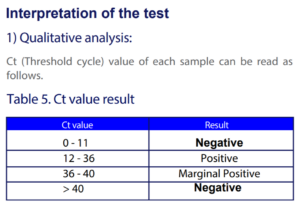As reported last week by the Sentinel, many labs are setting the cycle threshold on COVID tests above the recommended level, which, according to CDC calculations and many virologists, will produce false positives by detecting non-contagious particles. The Sentinel sent an Open Records request to Johnson County seeking the cycle threshold for every positive result in the county but officials said “the disease reporting system maintained by the Kansas Department of Health and Environment, does not contain cycle threshold data.”
In a series of follow-up questions, we asked if health officials, County Manager Penny Postoak-Ferguson, or county commissioners would like to have KDHE provide the cycle threshold information for past and future tests and if such a request will be made. We also asked if they believe the cycle threshold should be set no higher than 34 as suggested by the CDC and many virologists.
The emailed response on behalf of the county from Deputy Legal Director Cynthia Dunham said, “We have nothing further to add to our prior response to your KORA request.”
County Commissioner Mike Brown, however, sent his own reply.
“If the testing cycle threshold of Johnson County does not align with CDC guidance, that is wholly unacceptable and must be rectified immediately by Johnson County.”
Each COVID test manufacturer makes its own cycle threshold recommendation, but reporting by the New York Times says setting thresholds too high will detect genetic fragments that are not contagious.
“Tests with thresholds so high may detect not just live virus but also genetic fragments, leftovers from infection that pose no particular risk — akin to finding a hair in a room long after a person has left, Dr. Mina said.
“A more reasonable cutoff would be 30 to 35, she added. Dr. Mina said he would set the figure at 30, or even less. Those changes would mean the amount of genetic material in a patient’s sample would have to be 100-fold to 1,000-fold that of the current standard for the test to return a positive result — at least, one worth acting on.”
Dr. Michael Mina, quoted above, is an assistant professor of epidemiology at both Harvard Medical School and the Harvard T.H. Chan School of Public Health. He told Harvard Magazine that reporting people positive on tests with a high cycle threshold are “false positives.”
 One maker of the COVID PCR test, Bioningentech, offers guidance quite similar to those in the New York Times article. Cycle thresholds between 12 and 36 are considered positive; results between 36 and 40 cycles are considered marginally positive, and anything over 40 cycles is considered negative.
One maker of the COVID PCR test, Bioningentech, offers guidance quite similar to those in the New York Times article. Cycle thresholds between 12 and 36 are considered positive; results between 36 and 40 cycles are considered marginally positive, and anything over 40 cycles is considered negative.
But as the Sentinel reported last week, the Kansas Department of Health and Environment says its most commonly-used COVID PCR test is using a cutoff of 42 cycles.
Open Records request to KDHE
Students are being denied access to in-person learning based mostly on positive test result data, and now Governor Kelly is trying to convince the State Finance Council to allow her to impose a statewide mask mandate.
The Sentinel yesterday sent an Open Records request to KDHE seeking the cycle threshold of each positive test in Kansas. If the state says it doesn’t have the data, we’ll ask that they obtain it from the labs and make it public so Kansans can see how many false positives may be driving government actions.


